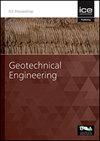Kinematic limit analysis of unsaturated stepped excavation slopes subjected to surcharge loads
IF 1.7
4区 工程技术
Q3 ENGINEERING, GEOLOGICAL
Proceedings of the Institution of Civil Engineers-Geotechnical Engineering
Pub Date : 2022-04-11
DOI:10.1680/jgeen.21.00220
引用次数: 0
Abstract
Stability assessment and design of stepped excavation slopes are of great practical significance and require explicit consideration of the three-dimensional (3D) effect and the suction-related effects. In the realm of 3D kinematic limit analysis theorem, this paper presents a semi-analytical method to quantify the suction impact in the stability assessments of stepped excavation slopes. The influences of surcharge load and seismic excitation are both considered from a kinematic perspective. Numerical experiments were conducted regarding the roles of soil suction, 3D effect, surcharge loads and seismic actions in the safety assessments. An example is presented to show the practical use of this method in engineering practice with respect to the determination of the optimum shape of a stepped excavation slope that characterized with fixed slope toe and slope crest positions. The results demonstrate that the stability of stepped excavation slopes can be improved by 10% ∼ 25% compared with those of single-stage slopes and the optimum depth coefficient (αopt) falls in 0.55 ∼ 0.7 for most cases. For steeper excavation slopes, αopt might exceed this range, while for gentler slopes, αopt tends to be smaller than this range. The critical slip surface and the 3D effect tends to be more pronounced as the surcharge load increases.附加荷载作用下非饱和阶梯开挖边坡的运动极限分析
阶梯式开挖边坡的稳定性评价与设计具有重要的现实意义,需要明确考虑边坡的三维效应和吸力效应。在三维运动极限分析定理领域,提出了一种半解析方法来量化阶梯式开挖边坡稳定性评价中的吸力冲击。从运动学角度考虑了附加载荷和地震激励的影响。对土吸力、三维效应、附加荷载和地震作用在安全性评价中的作用进行了数值试验。通过算例说明了该方法在确定坡脚和坡顶位置固定的阶梯式开挖边坡的最佳形状方面的实际应用。结果表明,梯级开挖边坡的稳定性比单级开挖边坡提高10% ~ 25%,大多数情况下的最佳深度系数(αopt)在0.55 ~ 0.7之间。对于较陡的开挖边坡,αopt可能超过该范围,而对于较缓的边坡,αopt则趋于小于该范围。随着附加载荷的增大,临界滑移面和三维效应趋于明显。
本文章由计算机程序翻译,如有差异,请以英文原文为准。
求助全文
约1分钟内获得全文
求助全文
来源期刊
CiteScore
4.40
自引率
4.50%
发文量
68
审稿时长
3 months
期刊介绍:
Geotechnical Engineering provides a forum for the publication of high quality, topical and relevant technical papers covering all aspects of geotechnical research, design, construction and performance. The journal aims to be of interest to those civil, structural or geotechnical engineering practitioners wishing to develop a greater understanding of the influence of geotechnics on the built environment.

 求助内容:
求助内容: 应助结果提醒方式:
应助结果提醒方式:


